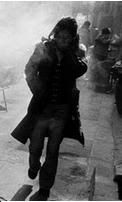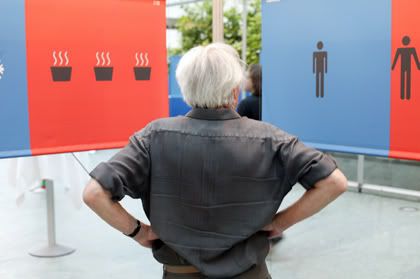
By reading this essay, those of the audience should come away with a much greater understanding of the many intricate and compelling differences between American and Chinese photography. This will be realized by analyzing several pieces of Hu Yang's "Shanghai Longtang Exhibition" for his use of lighting, stylistic focus of people and objects, and his proposed vectors of attention, and juxtaposing these elements against a Western counterpart's thought of the art of photography. By analyzing the artist's work thus, viewers should come away with a better understanding of world culture and art, as well as to better grasp the degree to which the Western, and primarily American, schools of thought influence the rest of the globe.
In his photo, “Shanghai Longtang-Pu Tuo District,” Hu works as he does with any of the other pieces from his Shanghai series; attempting to capture his hometown in its most  authentic and unaltered sense. For this reason, the photograph shows no special use of lighting, instead relying only upon the area's natural light. Doing so gives “... Pu Tuo District” an easier appeal, as if this street could be found in any urbanized city. This “homey” feeling, for lack of a better word, reinforces to the audience just how alike this seemingly foreign world can be to a Western onlooker. China may be centuries older than most European nations, with customs and a government unlike any in this hemisphere, but at the end of the day, Chinese cities can be just as ragged as any major Western metropolis, and its people fight many of the same struggles.
authentic and unaltered sense. For this reason, the photograph shows no special use of lighting, instead relying only upon the area's natural light. Doing so gives “... Pu Tuo District” an easier appeal, as if this street could be found in any urbanized city. This “homey” feeling, for lack of a better word, reinforces to the audience just how alike this seemingly foreign world can be to a Western onlooker. China may be centuries older than most European nations, with customs and a government unlike any in this hemisphere, but at the end of the day, Chinese cities can be just as ragged as any major Western metropolis, and its people fight many of the same struggles.
That is not to say, though, that either side's view of the world is symmetrical to the other's. The photograph's layout of figures in space is the most obvious incarnation of the differences in visual appeals between Western and Eastern cultures. Where an American artist may highlight the groups of people and the girl walking alone down the street, Hu begins his visual experience for the viewer at the smoke flume. The local onlooker would then follow on to the young girl, to the nearby building, even attempt to gain some knowledge about the people in the background. Following this native thought, one clearly notices the photographer's intended purpose: showing how the older generation in the back, used to a life working long hours in smokey coal mines, takes little notice of the thick smoke rising about them, while the youth, a generation who has never known such strenuous work, chokes in the small vapor.
Following Hu in this way makes the viewer take a second look at their own interpretation of the photo and the situation it presents. DesignSwan.com uses the work of Yang Liu to further illustrate many of these seemingly minor differences between the respective cultures (in this case Germany versus China, specifically). Understanding the discongruities between Easterners and Westerners in key places, like the complexities of social groups, the focus on independence, and the importance of oneself, primarily, gives new meaning to the ways in which Chinese photographers work. This picture is working to meld those worlds, because though it is apparent that the girl is one of the main focal points of the piece, she is not the only one. Rather, the photograph works to further explain the inter-connectivity of all of the figures involved, including the inanimate agents.
This being the case, it follows that many intersecting vectors of attention are used in this piece. In attempting to ground the onlooker in the native perspective, one should begin at the outer edge, noting the piece's angle and cropping. Surely when Hu took this picture, there were more workers in the background, and the building on the left took up much more space than it occupies in this representation. But that is not the photo's aim. The way in which the picture is cut leads the viewer to place more focus upon the walking girl, the worker crouched next to her, covered by the smoke, and even the smoke and light, themselves.
As one takes all this in, though, something still feels strange. The artist has ta ken the photo at a strange angle, one where the building acts as a sort of structural backbone, making the scene feel more level, yet one cannot help notice the strange angle at which the girl is leaning as she walks. Surely this isn't some natural gimp for her, but instead lends itself to the picture's appeals. Viewers are struck by this seeming oddity, and it makes them focus more upon that which seems unnatural. This speaks to the photograph's appeal to logos, defining how the world within it is arranged, but also defines a rather strict visual hierarchy, leading the onlooker from one object to the next, in an appeal to ethos. Strikingly, though she may not be the most important player within “... Pu Tuo District,” the young girl does lend herself to most of the work's rhetorical elements.
ken the photo at a strange angle, one where the building acts as a sort of structural backbone, making the scene feel more level, yet one cannot help notice the strange angle at which the girl is leaning as she walks. Surely this isn't some natural gimp for her, but instead lends itself to the picture's appeals. Viewers are struck by this seeming oddity, and it makes them focus more upon that which seems unnatural. This speaks to the photograph's appeal to logos, defining how the world within it is arranged, but also defines a rather strict visual hierarchy, leading the onlooker from one object to the next, in an appeal to ethos. Strikingly, though she may not be the most important player within “... Pu Tuo District,” the young girl does lend herself to most of the work's rhetorical elements.
Exploring photographs is a great way to learn about someone else. We learned to look at pictures in storybooks at an early age to help us comprehend what was going on. We use large visuals in newspapers to give an event more clarity to the reader. Even in getting to know a friend or relative, one might sift through old photo albums in an attempt to better connect with another.  For this reason, analyzing Hu Yang's “Shanghai Longtang-Pu Tuo District” for its rhetorical appeals, stylized elements, and use of light gives the viewer a better look into not only the day-to-day world of Shanghai, but also the distinct and scintillating anomalies between Western and Chinese approaches to photography.
For this reason, analyzing Hu Yang's “Shanghai Longtang-Pu Tuo District” for its rhetorical appeals, stylized elements, and use of light gives the viewer a better look into not only the day-to-day world of Shanghai, but also the distinct and scintillating anomalies between Western and Chinese approaches to photography.
No comments:
Post a Comment